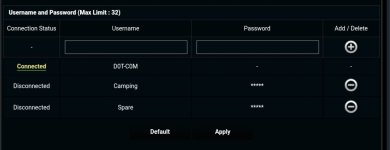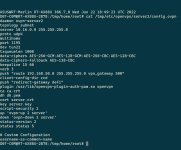I have 2 asus routers, an AX88U at home and a AC5300 at the remote site, that are linked through a bidirectional site to site VPN link. I use this link to access an ip camera remotely. Both routers are using the latest Merlin firmware.
Everything works great because I only have one client logged in on the vpn server at a time using 'client' as the common name. I don't really want to go through the headaches of creating custom client certs so I decided for the 2 or 3 vpn clients I would use a custom server script 'username-as-common-name' to use the username as the common name.
This works for the default username but if I use any of the usernames and passwords that I created at the bottom of the 'VPN Server' tab the clients 'auth fail' to authorize.
Why don't these usernames and passwords work for me?
In the meantime I've started a second VPN server so that I can log into that one without disrupting the first one
Everything works great because I only have one client logged in on the vpn server at a time using 'client' as the common name. I don't really want to go through the headaches of creating custom client certs so I decided for the 2 or 3 vpn clients I would use a custom server script 'username-as-common-name' to use the username as the common name.
This works for the default username but if I use any of the usernames and passwords that I created at the bottom of the 'VPN Server' tab the clients 'auth fail' to authorize.
Why don't these usernames and passwords work for me?
In the meantime I've started a second VPN server so that I can log into that one without disrupting the first one
Last edited:




